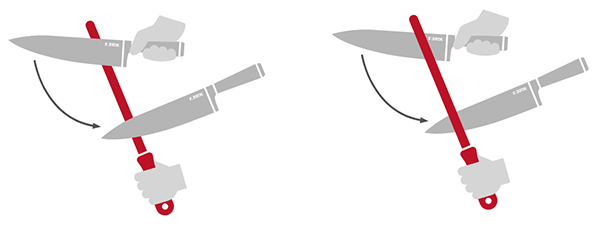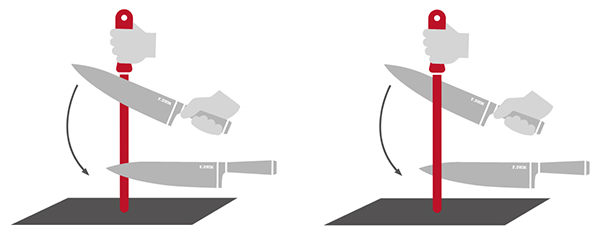THE ESSENTIALS OF PROPER SHARPENING STEEL CLEANING
The correct and regular cleaning of F. DICK sharpening steels is a basic requirement so that they can be used for as long as possible. It is essential that you clean your sharpening steel to keep it hygienic and bacteria-free, but above all fully functional. Note: incorrect cleaning can lead to rusting and pitting (corrosion) that damages the fine surface initially and even the sharpening steel blade over time. F. DICK sharpening steels are machine-washable, if possible we recommend gentle cleaning by hand using a mild alkaline cleaning agent. Different detergents were tested for their effectiveness and suitability for sharpening steels in practical tests carried out under laboratory conditions – also in cooperation with different detergent manufacturers.
HOW DO I CLEAN THE SHARPENING STEEL CORRECTLY?
Use the correct detergent suitable for metals; never use acidic agents. Do not use detergent that may cause metal corrosion (observe the safety data sheet). Use only a mild, alkaline, basic, chlorine-free detergent. Observe the correct use, temperature, dosage and cleaning time of the detergents. Please note the instructions for use! Do not use additional detergents. After cleaning, it is important to remove all traces of detergent from the sharpening steel. Use the rinse programme on your dishwasher to do this or rinse the sharpening steel thoroughly with water and then dry the steel with a soft, lint-free cloth.
WHAT SHOULD I KEEP IN MIND WHEN CLEANING THE SHARPENING STEEL?
- Only use suitable detergents.
- Do not clean with too high a dosage.
- Do not use acidic detergents.
- Do not clean for longer than the prescribed time.
- Do not leave any traces of the detergent on the sharpening steel.
- Do not expose continuously to high moisture levels.
- Do not expose for too long to fats, proteins and other organic contaminants.
- Rinse the sharpening steel as quickly as possible in the event of contact with spices/cooking salt.
- Do not use metal brushes for cleaning.
STERILIZATION
The short-term use of sterilizers up to a temperature of approx. 120° C is suitable for cleaning your sharpening steel. However, sharpening steels may not be exposed to force that may loosen the handle, e.g. from hanging them up. Sharpening steels have to cool down first before they are used again. The instructions for use supplied by the machine manufacturers must also be observed for the sterilization. We recommend a cleaning temperature of maximum 70° C, then your sharpening steel can be used again immediately.
HOW DO I SHARPEN MY KNIVES PROPERLY ON THE SHARPENING STEEL?
Handling a sharpening steel is not that difficult with a little practice. Place the knife blade at an angle of 15° - 20° on the sharpening steel and slide the blade alternately to the left and right along the steel. It is important to have the same number of sharpening movements on both sides. The sharpening movement has to begin with the end of the knife blade at the tip of the sharpening steel and be guided in a wide arc whilst applying light pressure to ensure that it ends with the tip of the knife close to the sharpening steel handle.

Hold the sharpening steel away from the body at an angle

Place the sharpening steel vertically on a surface.
It is important that you alternate the side of the knife that comes into contact with the sharpening steel. You should never first move one side of the knife and then the other side of the knife several times along the sharpening steel, otherwise a curved burr will form towards the other side of the knife, which will remain after the last sharpening movement. However, only a very fine burr forms with alternate sharpening (also known as a thread), which is removed by bending it back and forth. It is vital to apply less and less pressure towards the end of the alternate sharpening movement to ensure that the fine burr becomes weaker and weaker.
OUR TIP
Straighten the cutting edge by frequent, short sharpening before or after each use. Do not wait until you feel that the cutting performance of your knife is poorer.